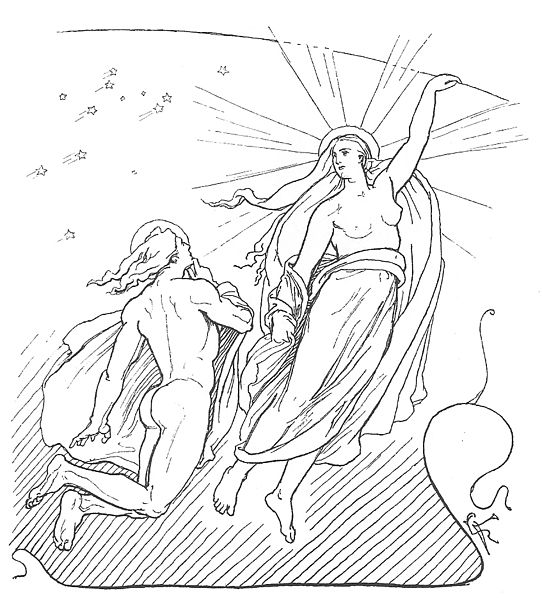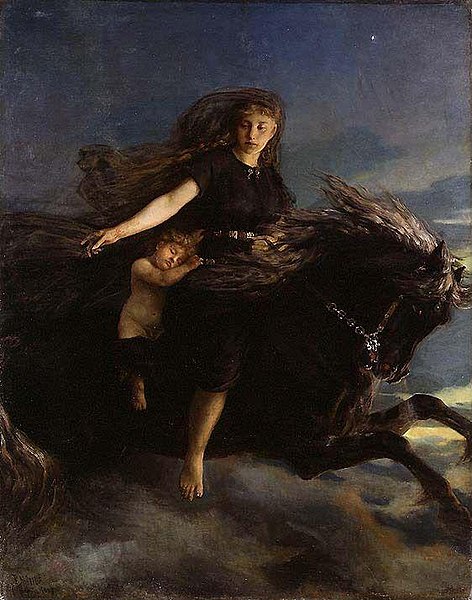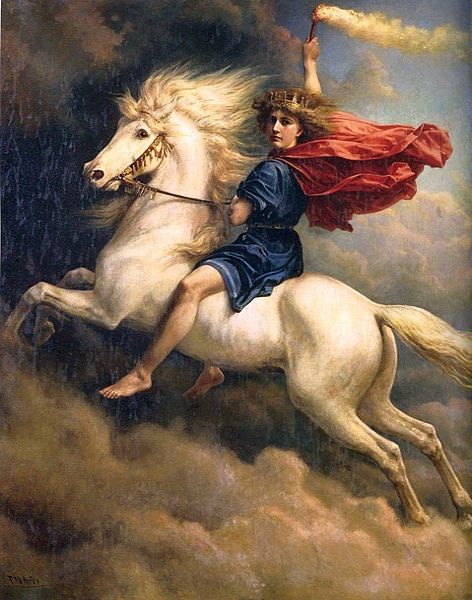In Norse mythology, the cosmic interplay of day and night, as well as the sun and moon, is personified by distinct celestial deities, each with their own lineage and roles.
The sun and the moon
Sól (or Sunna) is the goddess of the sun, and her brother Máni represents the moon. It was Odin, the Allfather, who set these heavenly bodies in motion, marking the rhythm of time.

Sól, married to Glenr, drives the sun chariot across the sky, pursued by the wolf Sköll. From their union, a daughter was born, Álfröðull (often referred to as “Elf Beam” or “Elf Disc” in English). While Álfröðull did not immediately follow her mother, she was destined to take over her role after Sól was devoured by Sköll. Protecting the earth from the sun’s full intensity is the shield Svalinn, positioned in front of Sól’s chariot. Without Svalinn, the earth would be set ablaze.
Máni, guiding the moon, is chased by the wolf Hati. He has taken two children from the earth, Bil and Hjúki, who carry a pail of water between them, symbolizing the waxing and waning phases of the moon.
Night and day


Nótt (Night), a jötun or giantess, is the embodiment of night and the daughter of Narfi. From her various unions, she bore several offspring, including Auðr (Wealth), Jörð (Earth), and Dagr (Day). Dagr, representing the day, is the offspring of Nótt’s union with Dellingr, an Aesir and the god of dawn. Together, Nótt and Dagr traverse the sky in their respective chariots, succeeding one another, symbolizing the eternal cycle of night and day. Their union, one of a jötun and an Aesir, underscores the intricate relationships and balance of powers in the Norse cosmos.
Norse vs. Greek Celestial Deities
The stories found in mythology, woven across different cultures, often converge on similar themes, especially when it comes to celestial deities. Both Norse and Greek mythologies, with their rich narratives and characters, offer insights into how these ancient civilizations perceived the sun, moon, day, and night.
Sun and Moon
- Norse: In Norse mythology, Sól (or Sunna) and her brother Máni represent the sun and moon, respectively. Sól drives her chariot across the sky, pursued by the wolf Sköll, while Máni guides the moon’s journey, symbolizing its phases with the children Bil and Hjúki. Both deities play crucial roles in marking the passage of time and the cyclical nature of the cosmos.
- Greek: The Greeks revered Helios as the sun god, who journeyed across the sky in a chariot, much like Sól. However, over time, Helios’ attributes were often merged with Apollo, the god of light and prophecy. Selene, the moon goddess, mirrors Máni’s luminous role but is more focused on her romantic involvements with mortals and gods, highlighting the moon’s influence on emotions.
Day and Night
- Norse: The eternal dance of night and day in Norse myths is personified by Nótt (Night) and Dagr (Day). Their continuous succession, with Nótt being a jötun and Dagr an Aesir, emphasizes the balance and interconnectedness of different cosmic entities.
- Greek: Hemera (Day) and Nyx (Night) stand as the Greek counterparts. As primordial deities birthed from Chaos, they underscore the foundational and elemental nature of day and night in the universe’s creation.
In summary, it is maybe unsurprising that in Greek myths, these deities led more active lives with lovers and intrigue. The Norse celestial deities seem to have been simpler, more singularly focused with less of a backstory.
I have written separate blog posts for them where I go into more depth regarding each god and goddess which I am linking to below.
Featured Image Credit: John Charles Dollman, Public domain, via Wikimedia Commons

Thank you for this!
Is Dagr also called Sol, Sunna or Álfröðull (Old Norse “elf-beam” or “elf-disc”?
Could Dagr have been introduced after Álfröðull and Sunna, as Dagr mirrors the Greek-Roman mythos?
Love your work here! THANK YOU!
Hi John, thank you for taking an interest in this post and your feedback. YOur first question is really the easiest as Dagr is the personification of the time that it’s light outside, ie. day, and is infact a male, where as Sol/Sunna is the female personification/goddess of the actual sun. However, Álfröðull is more difficult to define. Its translation is a point of discussion, but Alfr-disc/heaven pops up a few places. However, as is often the case in Norse mythology, this is a kenning, or synonym for something, or someone else. It could be for Sunna/Sol, but that isn’t for certain.